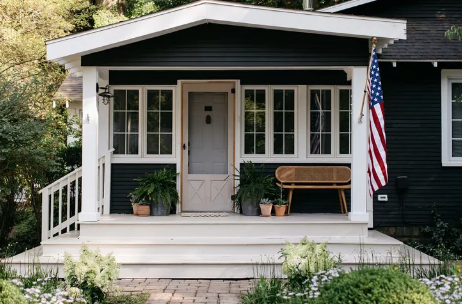A small front yard doesn’t have to limit your creativity or curb appeal. With just a few expert tips, you can make the most of your space without spending hours maintaining it. The best part? Many of these ideas also support local wildlife and pollinators. Whether you’re drawn to native flowers and ornamental grasses or want a drought-tolerant, low-water landscape, there’s no shortage of easy-care options.
1. Drought-Tolerant Native Plants
One of the best ways to create a low-effort, eco-friendly garden is by choosing the right plants. Native plants that thrive in your region and don’t require much water are both sustainable and easy to care for.
In small front yards, native, drought-tolerant plants are a great alternative to thirsty lawns. They support pollinators and help expand habitat for local wildlife. Try planting clumping grasses—they deliver major visual impact in small spaces and thrive year-round once established.
Spend some time researching native species in your area to find plants that will grow strong and also benefit the local ecosystem.
2. Dwarf Fruit Trees
Don’t let limited space stop you from growing something edible. While you might not have room for a full orchard, dwarf fruit trees are a great solution for small front yards.
They bring vertical interest, seasonal flowers, and fresh fruit—all in a compact form. As always, choose varieties that are suited to your local climate and USDA hardiness zone.
Depending on where you live, good small-space options include citrus fruits like lemons and oranges, plums, cherries, and figs.

3. Ornamental Grasses
When planning a small front yard, ask yourself a few key questions: Is the space sunny or shady? Do deer roam nearby? What’s your budget? No matter your answers, ornamental grasses can often check all the boxes.
There’s a grass for every height, and most are deer-resistant. For example, Karl Foerster feather reed grass (or its variegated version, ‘Overdam’) grows upright and stays colorful all winter long.
Complement your grasses with low-growing perennials like the soft purple catmint ‘Junior Walker’ or the charming geranium ‘Biokovo.’ These plants spread across the ground, help suppress weeds, and add seasonal interest.
4. Wildflower Meadows
Want big color and texture with minimal effort? A wildflower meadow could be the perfect fit.
Meadow-style gardens are a low-maintenance, eco-friendly alternative to manicured lawns. They require less mowing and watering, and they’re a haven for local birds, bees, and butterflies.
This is also a chance to explore native species that grow well in your area—especially those that spread naturally. It’s a great way to support pollinators and enjoy a vibrant front yard all season long.

5. Xeriscaping
Saving water is another smart way to cut down on yard maintenance—and it’s often more budget-friendly and better for the environment. If you live in a warm, dry climate, xeriscaping could be the way to go.
Xeriscape designs often include rock gardens filled with drought-tolerant succulents. Most plants native to your region are already adapted to the local climate, which means they require less watering, weeding, and fertilizing.
Even if you don’t live in a hot, arid area year-round, this landscaping style can still work beautifully in dry zones and during drought seasons.

